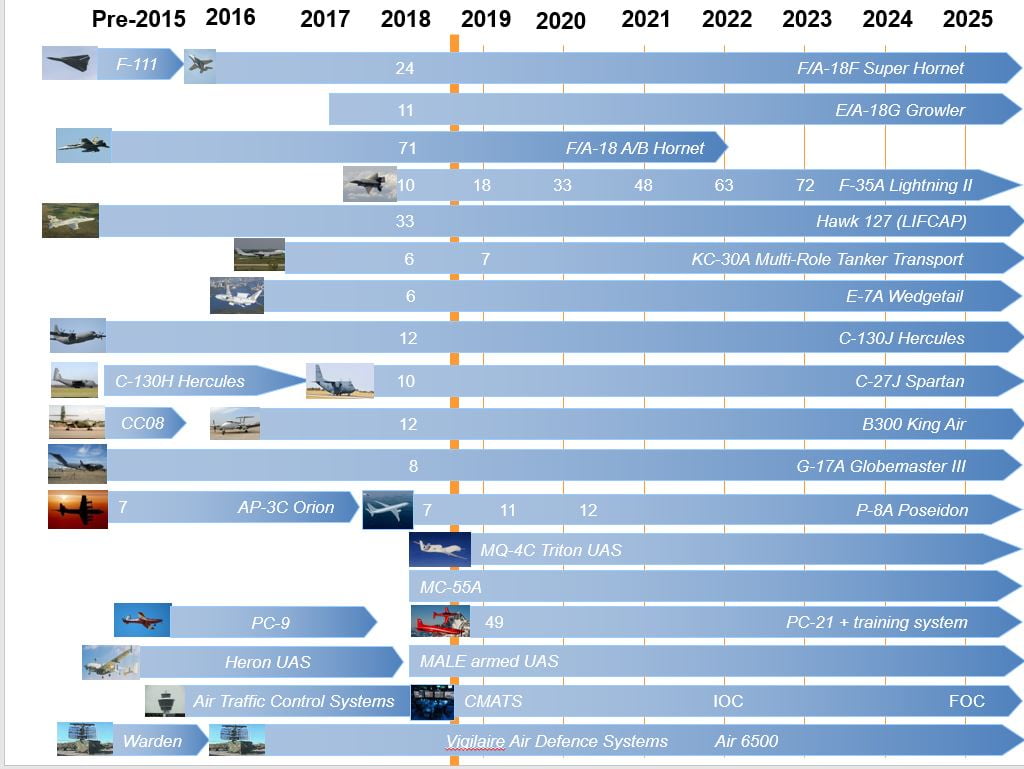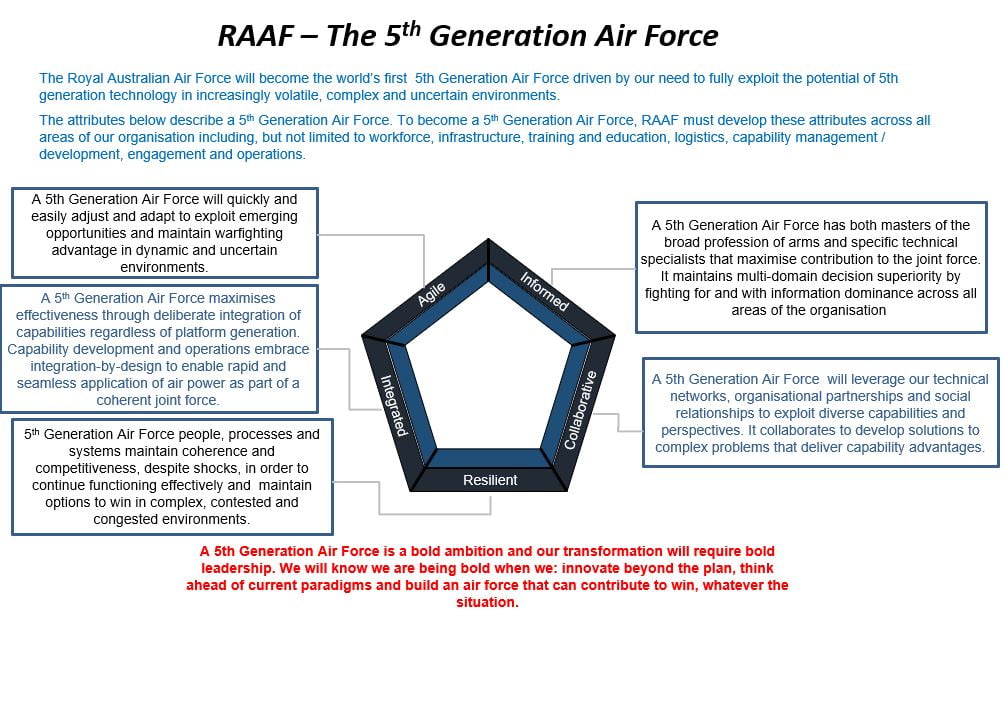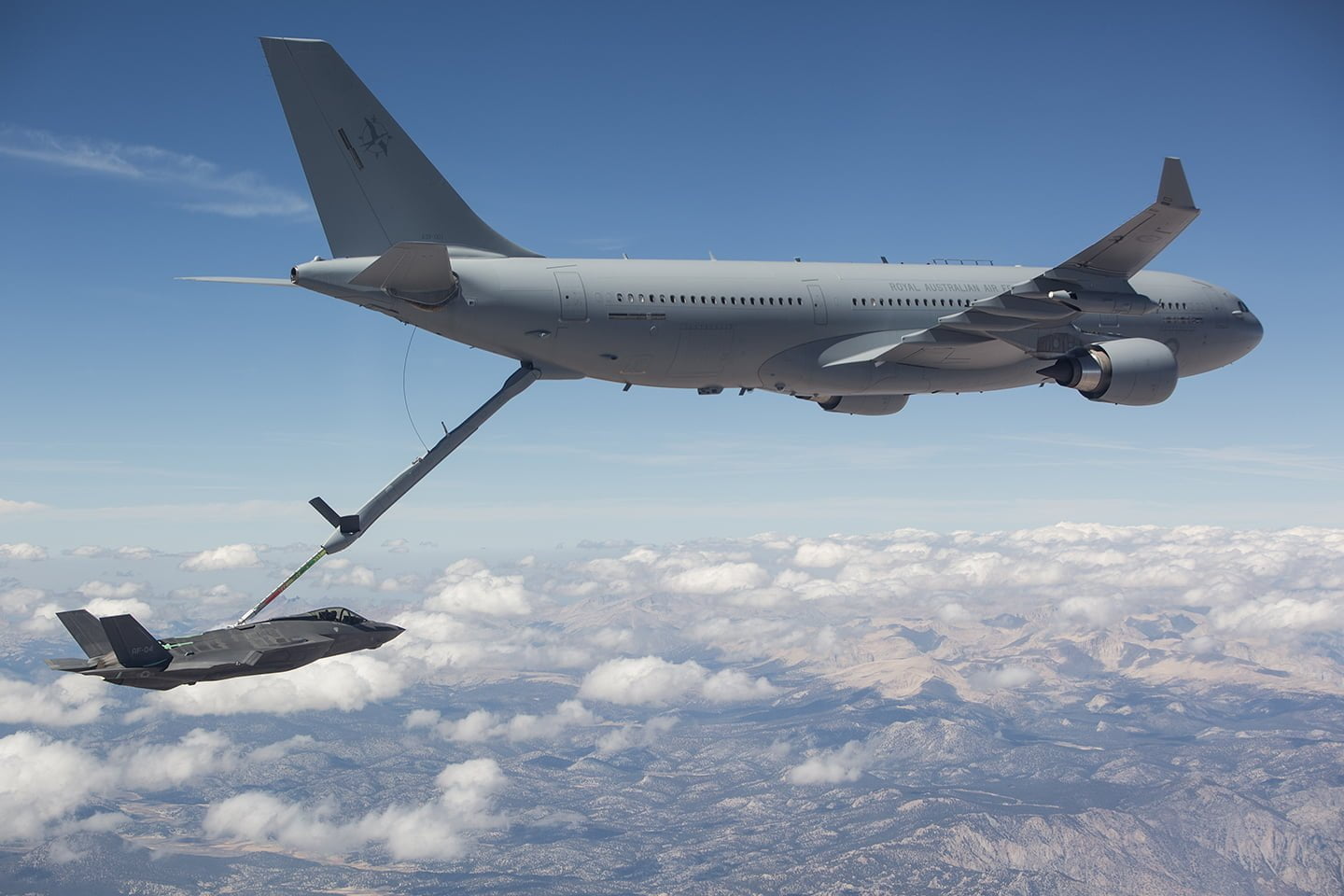By Robbin Laird
At the International Fighter Conference 2018, Air Marshal (Retired) Geoff Brown provided an overview of how the RAAF has shaped a way ahead along with the Australian Defence Force to craft what they refer to as a fifth-generation combat force.
In the case of the Royal Australian Air Force (RAAF) and the Australian Defence Force (ADF), the acquisition of the F-35 has been seen as not providing a replacement aircraft but a trigger to broader force transformation, with a future is now mentality.
Brown provided an overview of how the ADF is looking at the crafting of a fifth gen force or a fifth generation enabled force and some of the highlights from his presentation underscore how the Aussies are looking at this dynamic of change.
For the last 5 – 10 years in Australia we have been determining the characteristics of combat operations in the post 2025 era.
The RAAF we have been very fortunate to have been well supported and funded by government.

In the RAAF it’s been nice to say that most pieces of the future combat fleet are in place or that the funding has been secured. It will be a F-35’s supplemented by Super Hornets and they will well be supported by systems like Wedgetail, Growler, KC-30s, and air defence systems like Vigilaire and over-the-horizon radar, and I even think the Maritime Patrol Fleets, P-8s and Tritons, will all contribute to the air combat system…..
We have concluded in Australia, that air operations will be characterized by the capability to connect air, ground and maritime forces.
In the ADF we have actually called that 5th Generation enabled CONOPs. The ultimate goal is that the combat and strike power of a single aircraft is not defined by what it carries itself but by its ability to direct and rely upon its network partners. Even to the point of using other platforms weapons. We have been in the process of developing 5th Gen CONOPS across the ADF informed by the forcing function of 5thGen aircraft and the associated air, maritime and land systems.
In a 5thGen force, C2 systems will be enabled by flying ISR and C2 system, the combination of sensors and Stealth will enable aircraft like the JSF to operate in an Adversaries airspace and allow aircraft to serve as nodes in a dispersed and distributed air battle management system….
One of the things that the critics of the F-35 don’t get is, in all the studies of air combat, the amazing statistic is that 5% of the pilots have taken 95% of the kills. Now, when you do the analysis of those 95% of the kills and what makes the difference with those 5% of pilots, it was their superior situational awareness in all the situations that they faced that made the difference. And the F-35 gives you a massive leap in situational awareness, and that’s the key factor in 5th generation capability. It’s the integrated fused picture.
It’s worth briefly working through the value chain of the F-35. I’ll start in operations and I’ll work my way towards fundamental inputs to capability, and we’ll just have a bit of a look at some areas that we have been working on.
Over the last 10 years I almost get a hoarse voice trying to explain to people why 5th generation capabilities are important in the F-35 and why speed and maneuverability don’t necessarily have the same impact that they previously had.
What is 5th generation?
It’s low observability, it’s a low infrared signature, it’s low electronic emissions, it’s an AESA radar, it’s the data links associated with that, but the most important thing in my mind that the JSF brings is the fused picture – that situational awareness that it actually brings to the operator.
And your level of situational awareness is a combination of all those things. If you look at the difference between an F-35 and a legacy platform, you don’t have to manipulate the sensors. You’ve got a fused picture on the display, you don’t have to have as much communications between the flights; the pilots fundamentally got a lot more brain space to actually look at the tactical situation and go forward.
Now what are the implications for Air Battle Management?
We’re already implemented some of this with the rest of the ADF.
We’re successfully fusing the picture between Wedgetail and the Navy Destroyers and Frigates. One of the great decisions we made with Wedgetail was that on each one of the crews there’s a Navy Air Intercept Controller. We’ve had Mission Commander who’s are Navy Lieutenant Commanders – and our recent experience on exercises and in Iraq and Syria with the Super Hornet and Wedgetail have really shown the power of that integration.
When you look at the F-35 be able to find, fix, track, target, engage and assess. That’s the cycle. The JSF can do that all by itself, but it is far more powerful if you look at the find and fix and you use a lot of the systems we’ve got from Vigilare to JORN to Space Based Systems, to maybe even the Triton and P-8.
They’re all part of that find and fix. And if I was to look at track – Wedgetail, AWD, Growler are all parts of that. The engage – well, that’s the job of Super Hornet, JSF and Growler, and what we aspire to is to have, some integrated fire control with the Royal Australian Navy. That’s all well within the realms of possibilities.
The more nodes you’ve got, the better off it is for the entire system. And what we see is the advantage of the F-35, it does increase the capability of the entire system….
After his presentation, I had a chance to sit down and discuss his presentation and the way ahead for the ADF leveraging the F-35 as a trigger point for change.
In the discussion after his presentation, Air Marshal (Retired) Brown highlighted a number of key points which he believes are central to thinking about the future of airpower.
First, he argued that buying an advanced plane and getting on with it was crucial
“70% of your cost is about maintaining, supporting and modernizing your airplane. Why would you want to do that with a legacy jet when you can buy a fifth gen jet?”
Second, by getting the F-35 into service, the ADF could then look to add what is missing to that jet or to the air system and then look to shed legacy assets.
A case in point is support to the Australian Navy.
“When we have an effective maritime strike weapon onboard the F-35, we will look to retire our Super Hornets, with the exception of the Growler. Flying the Super Hornet has prepared us for F-35 in some key ways, notably in terms of the security requirements necessary to manage data generated by the aircraft.”
Third, the 5thgen approach as characterized by Brown is a shift to working the interconnected force in a different way.
He provided an example with regard to CEC and the Air Warfare destroyer.
“Our Navy has just started deploying our air warfare destroyers but we have already demonstrated CEC interoperability with the US Navy.
“We will put CEC on our Wedgetails to be able to provide weapons quality tracks to our ships, hence enhancing significantly the range for the strike capability of our fleet.
“And as we go forward we will find ways to directly link our F-35s with the fleet as well.
“Our Navy and Army are now focused on fifth generation communciaitons with their platforms as well, which is why having the F-35 in the force can drive change in the strategic direction in which you want to go.
“You fly a legacy asset you cannot drive the kind of change the ADF needs in the near to mid-term.
“It is not an abstract, long-range aspiration or goal.
“As the head of the RAF Lightning force, noted, the future is now.”
Fourth, the change in the overall structure of the ADF and the architecture to guide its development is being driven by a fifth-generation mentality and approach as well.
“Our architecture is not up to speed with what the F-35 can provide.
“We have a great airplane with enormous capability which will continue to evolve but a lot of the supporting infrastructure we’ve got is not designed to get the best out of that airplane.
“And I think that our focus needs to be on getting the rest of the system up to speed.”
Finally, fifth generation warfare training requires a paradigm shift.
“If you want an integrated system, you’ve got to train with an integrated system.
“You can exploit a lot of the capabilities that the F-35 brings to the fight in the live environment but the only place you can do it as a force is in the simulated environment.
“We need to develop fifth gen warfare networked simulation capabilities.
“And you just can’t afford for the simulated environment to be behind the airplane.
“It’s got to be updated at the same rate that the aero plane is being updated.

The featured photo shows F-35 Aircraft AF-4 Australian KC-30 Tanker Test.
The Royal Australian Air Force (RAAF) completed the first fuel transfer with the air refuelling boom from a RAAF KC-30A Multi-Role Tanker Transport (MRTT) to a US Air Force (USAF) F-35A Joint Strike Fighter at Edwards Air Force Base in California.
A total of 59 contacts were conducted of which five contacts transferred 43,200 pounds of fuel during the four hour sortie.
September 2015.
The International Fighter Conference 2018 was held from November 12-14 2018 and was organized by IQPC Germany.
Next year’s conference will be held from November 12-14 2019.


